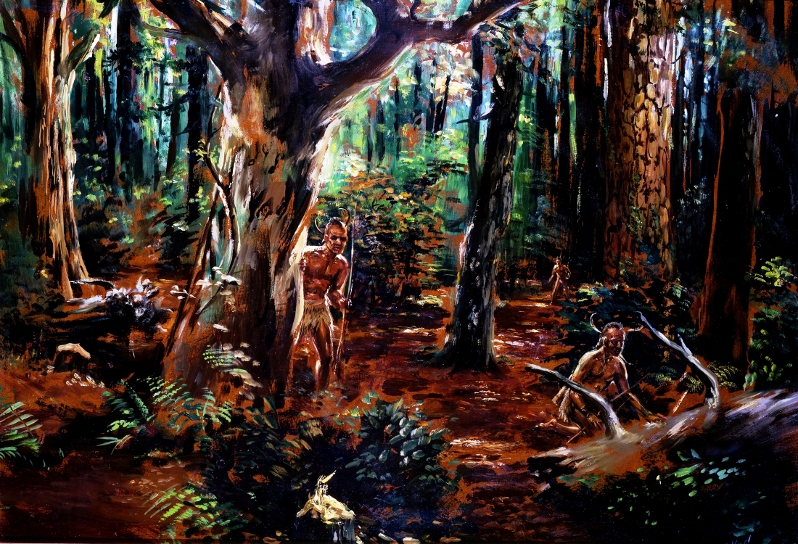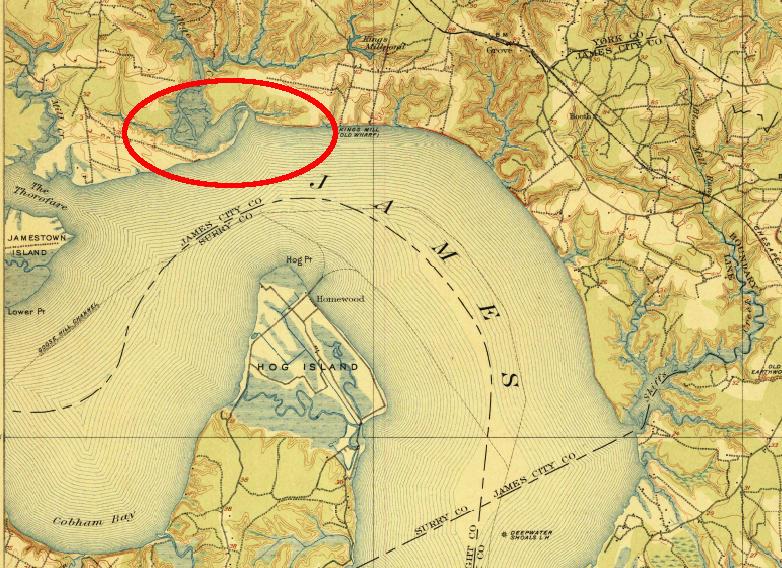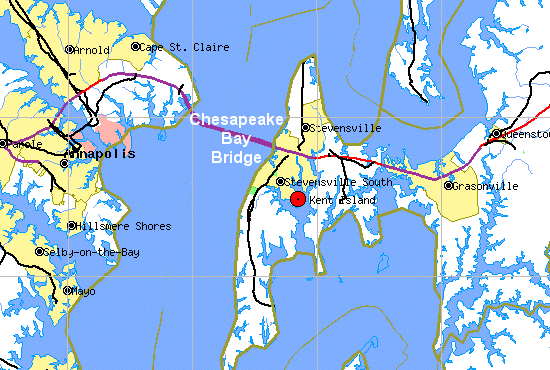
Sidney King painting, "Outside the James Fort," of Algonquians in Virginia when English colonists arrived at Jamestown
Source: National Park Service - Sidney King paintings
We don't know which human first spent the night in Virginia, or when they arrived, or even from which direction they came. Discovery Channel says she, or he, was an "Ice Age Columbus," but we have no written records - so we must interpret the scarce physical remnants of our earliest Virginians to get a sense of that discovery.
Perhaps the oldest sign of a human campsite in Virginia is at Cactus Hill, on the edge of the Nottoway River in Sussex County. Archeologists discovered Cactus Hill after a local resident noted old artifacts in dirt being dumped on local roads. The archeological site was an a sand dune being quarried for use in road maintenance. A combination of quick thinking and a cooperative landowner (International Paper at the time) has stimulated a healthy debate regarding the length of time Virginia has been occupied, though looting of the site by "thieves of time" seeking artifacts has threatened the loss of priceless information.
The real "First Families of Virginia" (FFV's) were not the English FFV's who arrived in the 1600's. The European settlers who sailed from London in 1606, and arrived in April 1607 to establish Jamestown, were 10-15,000 years too late to be "first."

However, in a lot of high schools the American history textbooks present a thin description of North America before the arrival of the Europeans, then quickly narrow the focus to the activities of the English who settled Jamestown, arrived in the Mayflower, won the Revolutionary War, crafted democracy, invented iPods... If you're not careful, you might assume there was a "manifest destiny" for the English to:
But did you know that the Spanish got to "Virginia" first (if you ignore 15,000 or so years of human occupation by Native Americans)? Yes, the Spanish were the first Europeans to try to establish a colony in Virginia.
Father Juan Baptista de Segura led a group that landed in 1570 in Virginia. One educated guess is that the Spanish landed at the mouth of what would later be called College Creek, after William and Mary College, just downstream of where Jamestown would be founded by the English 37 years later. The Spanish may then have traveled to what is now the Cheatham Annex of Naval Weapons Station Yorktown, and created their first settlement on the York River side of the Peninsula. That site was across the York River from Werowocomoco, a spiritual center for the Algonquians and Powhatan's capital when the English arrived in 1607.1

Our cultural geography could have been very different if that Spanish expedition been successful. The Chesapeake Bay could have ended up being called the "Bahia de Santa Maria" ("the bay of St. Mary"), the term used by the Spanish sailors.
Had the Spanish settled Virginia, then Spanish churches in Virginia might have reflected the pattern of the Spanish missions in Florida. Major investments might have been made in converting the Native Americans to Catholicism, rather than expelling the Powhatans from Tidewater (with the exception of a few tiny reservations, two of which remain today from colonial times).
The Spanish colonization model was based on establishing towns, such as St. Augustine - in clear contrast to the scattered settlement pattern in Virginia in the first century under the English, who created separate plantations with separate wharfs on rivers in Tidewater.
On the other hand, if the French had settled Virginia rather than the English or the Spanish, the economics of the Chesapeake Bay colony could have been based on fishing and fur trading, rather than settlement and tobacco agriculture. The initial French colonies in the New World were started before Jamestown, with efforts in Quebec (1541), South Carolina (1562), and Maine (1604). A 1613 French colony on Mount Desert Island in Maine (location of Acadia National Park now) was destroyed by Virginians led by Samuel Argall, who sailed up from Jamestown on an expedition that combined fishing and elimination of international rivals.
History is full of "what if" questions. Settlement by a different European country would have resulted in a dramatically different culture in colonial Virginia. It is possible that the French and the Spanish, unlike the English, would have focused on trade and sent relatively few settlers to their colony. Had any country other than England taken control of the Chesapeake Bay, the colony certainly would not have been named Virginia after the unmarried and therefore "virgin" Queen Elizabeth.
Did you know the Swedes also affected trade in Virginia? They established a colony in New Sweden (what is now the state of Delaware). The Swedish Fort Christina (now Wilmington) was founded in 1638, and it grew with the help of a Virginian, William Claiborne.
After Charles I granted the northern part of the Chesapeake Bay to the Calvert family in a 1632 charter, the Calverts evicted William Claiborne of Virginia from Kent Island (the eastern end of the modern Chesapeake Bay Bridge carrying Route 50 to Ocean City). Claiborne had started a fur-trading settlement there in 1631, after receiving a grant to the island from the Virginia Assembly and governor. After the 1632 royal grant, the Marylanders refused to honor land claims made by their colonial rivals in Jamestown.

Claiborne retaliated for his expulsion by disrupting the fur trade in Maryland. He convinced the Susquahannocks in the upper Chesapeake Bay to trade their furs with the Swedes at Fort Christina on the Atlantic Ocean to the northeast, rather than with the Marylanders at Kent Island.
Claiborne also led rebellions that almost deposed the Calverts in 1641 - and again fourteen years later, after Puritans had seized control in England and Virginia during the English Civil War. In 1655, Claiborne led Puritans from Virginia in a military operation that defeated the Calvert-appointed governor at the Battle of the Severn. The intensity of the fighting is shown by the casualty figures. Nearly 50 people were killed - a substantial number, when Virginia was actively recruiting new settlers with grants of 50 acres per person. (Virginia's boundary disputes with Maryland included actual fighting again in the 1950's as well, when watermen and police patrols shot at each other during the Oyster Wars.)